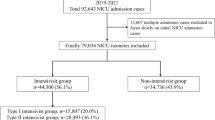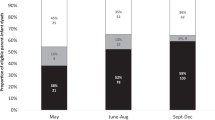Abstract
Objective
Assess practices supporting care transitions for infants and families in the neonatal intensive care unit (NICU) using a model of four key drivers: communication, teamwork, family integration, and standardization.
Study design
Single-day audit among NICUs in the Vermont Oxford Network Critical Transitions collaborative addressing policies and practices supporting the four key drivers during admission, discharge, shift-to-shift handoffs, within hospital transfers, and select changes in clinical status.
Results
Among 95 NICUs, the median hospital rate of audited policies in place addressing the four key drivers were 47% (inter-quartile range (IQR) 35–65%) for communication, 67% (IQR 33–83%) for teamwork, 50% (IQR 33–61%) for family integration, and 70% (IQR 56–85%) for standardization. Of the 2462 infants included, 1066 (43%) experienced ≥1 specified transition during the week prior to the audit.
Conclusions
We identified opportunities for improving NICU transitions in areas of communication, teamwork, family integration, and standardization.
This is a preview of subscription content, access via your institution
Access options
Subscribe to this journal
Receive 12 print issues and online access
$259.00 per year
only $21.58 per issue
Buy this article
- Purchase on SpringerLink
- Instant access to full article PDF
Prices may be subject to local taxes which are calculated during checkout


Similar content being viewed by others
References
Gray JE, Davis DA, Pursley DM, Smallcomb JE, Geva A, Chawla NV. Network analysis of team structure in the neonatal intensive care unit. Pediatrics. 2010;125:e1460–7.
Edwards EM, Ehret DEY, Soll RF, Horbar JD. Vermont Oxford Network: a worldwide learning community. Transl Pediatr. 2019;8:182–92.
Beck AF, Edwards EM, Horbar JD, Howell EA, McCormick MC, Pursley DM. The color of health: how racism, segregation, and inequality affect the health and well-being of preterm infants and their families. Pediatr Res. 2020;87:227–34.
Stevenson DK, Wong RJ, Profit J, Shaw GM, Jason Wang C, Lee HC. “Following through”: addressing the racial inequality for preterm infants and their families. Pediatr Res. 2020;87:192–3.
Horbar JD, Soll RF, Edwards WH. The Vermont Oxford Network: a community of practice. Clin Perinatol. 2010;37:29–47.
Institute of Medicine. Crossing the quality chasm: a new health system for the 21st century. 1st ed. Washington, DC: National Academies Press; 2001.
Little GA, Horbar JD, Wachtel JS, Gluck PA, Muri JH. Evolution of quality improvement in perinatal care in toward improving the outcome of pregnancy III. 2010. https://www.marchofdimes.org/toward-improving-the-outcome-of-pregnancy-iii.pdf.
Riley W, Davis S, Miller K, Hansen H, Sainfort F, Sweet R. Didactic and simulation nontechnical skills team training to improve perinatal patient outcomes in a community hospital. Jt Comm J Qual Patient Saf. 2011;37:357–64.
Salas E, Cooke NJ, Rosen MA. On teams, teamwork, and team performance: discoveries and developments. Hum Factors. 2008;50:540–7.
Salas E, Gregory ME, King HB. Team training can enhance patient safety–the data, the challenge ahead. Jt Comm J Qual Patient Saf. 2011;37:339–40.
Shuffler ML, DiazGranados D, Salas E. There’s a science for that: team development interventions in organizations. Curr Directions Psychological Sci. 2011;20:365–72.
TeamSTEPPS. TeamSTEPPS 2.0 Pocket guide: team strategies & tools to enhance performance and patient safety. AHRQ Pub No 14-0001-2. Rockville, MD: AHRQ; 2013.
DeMauro SB, Douglas E, Karp K, Schmidt B, Patel J, Kronberger A, et al. Improving delivery room management for very preterm infants. Pediatrics. 2013;132:e1018–25.
Katheria A, Rich W, Finer N. Development of a strategic process using checklists to facilitate team preparation and improve communication during neonatal resuscitation. Resuscitation. 2013;84:1552–7.
The Joint Commission. Inadequate hand-off communication. Sentinel Event Alert, Issue 58, September 12, 2017. https://www.jointcommission.org/assets/1/18/SEA_58_Hand_off_Comms_9_6_17_FINAL_(1).pdf. Accessed 6 Nov 2019.
Albritton J, Maddox L, Dalto J, Ridout E, Minton S. The effect of a newborn telehealth program on transfers avoided: a multiple-baseline study. Health Aff (Millwood). 2018;37:1990–6.
Balakrishnan M, Raghavan A, Suresh GK. Eliminating undesirable variation in neonatal practice: balancing standardization and customization. Clin Perinatol. 2017;44:529–40.
Luria JW, Muething SE, Schoettker PJ, Kotagal UR. Reliability science and patient safety. Pediatr Clin North Am. 2006;53:1121–33.
Pronovost PJ, Berenholtz SM, Goeschel CA, Needham DM, Sexton JB, Thompson DA, et al. Creating high reliability in health care organizations. Health Serv Res. 2006;41:1599–617.
Rozich JD, Howard RJ, Justeson JM, Macken PD, Lindsay ME, Resar RK. Standardization as a mechanism to improve safety in health care. Jt Comm J Qual Saf. 2004;30:5–14.
Starmer AJ, Spector ND, Srivastava R, West DC, Rosenbluth G, Allen AD, et al. Changes in medical errors after implementation of a handoff program. N Engl J Med. 2014;371:1803–12.
Petersen LA, Orav EJ, Teich JM, O’Neil AC, Brennan TA. Using a computerized sign-out program to improve continuity of inpatient care and prevent adverse events. Jt Comm J Qual Improv. 1998;24:77–87.
Bate P, Robert G. Experience-based design: from redesigning the system around the patient to co-designing services with the patient. Qual Saf Health Care. 2006;15:307–10.
The Point of Care Foundation. Carrying out observations. https://www.pointofcarefoundation.org.uk/resource/experience-based-co-design-ebcd-toolkit/step-by-step-guide/5-carrying-observations/. Accessed 29 Nov 2018.
Patrick SW, Schumacher RE, Horbar JD, Buus-Frank ME, Edwards EM, Morrow KA, et al. Improving care for neonatal abstinence syndrome. Pediatrics. 2016;137:e20153835.
Hagadorn JI, Sink DW, Buus-Frank ME, Edwards EM, Morrow KA, Horbar JD, et al. Alarm safety and oxygen saturation targets in the Vermont Oxford Network iNICQ 2015 collaborative. J Perinatol. 2017;37:270–6.
Ho T, Buus-Frank ME, Edwards EM, Morrow KA, Ferrelli K, Srinivasan A, et al. Adherence of newborn-specific antibiotic stewardship programs to CDC recommendations. Pediatrics. 2018;142:e20174322.
Kuzniewicz MW, Parker SJ, Schnake-Mahl A, Escobar GJ. Hospital readmissions and emergency department visits in moderate preterm, late preterm, and early term infants. Clin Perinatol. 2013;40:753–75.
Underwood MA, Danielsen B, Gilbert WM. Cost, causes and rates of rehospitalization of preterm infants. J Perinatol. 2007;27:614–9.
Gavey J. Parental perceptions of neonatal care. J Neonatal Nurs. 2007;13:199–206.
Machut KZ, Datta A, Stoller JZ, Rao R, Mathur A, Grover TR, et al. Association of neonatologist continuity of care and short-term patient outcomes. J Pediatr. 2019.
Horbar JD, Edwards EM, Greenberg LT, Morrow KA, Soll RF, Buus-Frank ME, et al. Variation in performance of neonatal intensive care units in the United States. JAMA Pediatr. 2017;171:e164396.
Spitzer AR. Has quality improvement really improved outcomes for babies in the neonatal intensive care unit? Clin Perinatol. 2017;44:469–83.
The Joint Commission. The Joint Commission transitions of care (ToC) portal. https://www.jointcommission.org/toc.aspx. Accessed 12 Aug 2019.
The Joint Commission. Hot topics in health care: transitions of care: the need for a more effective approach to continuing patient care. https://www.jointcommission.org/assets/1/18/Hot_Topics_Transitions_of_Care.pdf. Accessed 11 Sept 2019.
Funding
RFS, JDH, and KAM are employees of the Vermont Oxford Network (VON). MEB-F was employed by VON during the conduct of this work. EME is funded by a grant from VON to the University of Vermont. HCK, JM, WT, HC, and MF have served as faculty for VON.
Author information
Authors and Affiliations
Contributions
HCK substantially contributed to the conception and design of the work, analyzed and interpreted the data, drafted the initial manuscript, created the tables and figures, and critically revised the manuscript for important intellectual content. EME and KAM substantially contributed to the analysis and interpretation of the data, assisted in creation of tables and figures, and critically revised the manuscript for important intellectual content. JM, WT, HC, ES, RFS, MEB-F, JDH, and MF substantially contributed to the conception and design of the work and critically revised the manuscript for important intellectual content.
Corresponding author
Ethics declarations
Conflict of interest
The authors declare that they have no conflict of interest.
Additional information
Publisher’s note Springer Nature remains neutral with regard to jurisdictional claims in published maps and institutional affiliations.
Supplementary information
Rights and permissions
About this article
Cite this article
Kaplan, H.C., Edwards, E.M., Soll, R.F. et al. Variability in the systems of care supporting critical neonatal intensive care unit transitions. J Perinatol 40, 1546–1553 (2020). https://doi.org/10.1038/s41372-020-0720-3
Received:
Revised:
Accepted:
Published:
Issue date:
DOI: https://doi.org/10.1038/s41372-020-0720-3
This article is cited by
-
A quality improvement project improving post-operative transitions of care in a level IV NICU
Journal of Perinatology (2025)
-
Multidisciplinary evidence-based tools for improving consistency of care and neonatal nutrition
Journal of Perinatology (2024)
-
Shift-to-shift handoffs in the NICU: lessons learned from a large scale audit
Journal of Perinatology (2023)
-
Acute care utilization disparities among publicly insured preterm infants
Pediatric Research (2021)



